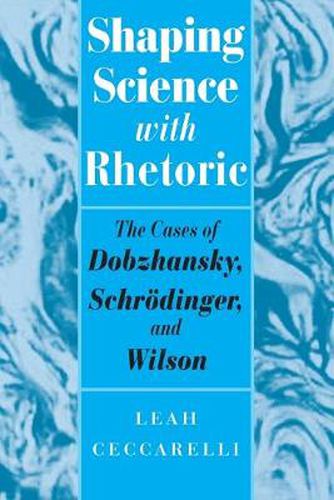Readings Newsletter
Become a Readings Member to make your shopping experience even easier.
Sign in or sign up for free!
You’re not far away from qualifying for FREE standard shipping within Australia
You’ve qualified for FREE standard shipping within Australia
The cart is loading…






How do scientists persuade colleagues from diverse fields to cross the disciplinary divide, risking their careers in new interdisciplinary research programs? Why do some attempts to inspire such research win widespread acclaim and support, while others do not?
In Shaping Science with Rhetoric, Leah Ceccarelli addresses such questions through close readings of three scientific monographs in their historical contexts–Theodosius Dobzhansky’s Genetics and the Origin of Species (1937), which inspired the modern synthesis of evolutionary biology; Erwin Schr 6dinger’s What Is Life? (1944), which catalyzed the field of molecular biology; and Edward O. Wilson’s Consilience (1998), a so far not entirely successful attempt to unite the social and biological sciences. She examines the rhetorical strategies used in each book and evaluates which worked best, based on the reviews and scientific papers that followed in their wake.
Ceccarelli’s work will be important for anyone interested in how interdisciplinary fields are formed, from historians and rhetoricians of science to scientists themselves.
$9.00 standard shipping within Australia
FREE standard shipping within Australia for orders over $100.00
Express & International shipping calculated at checkout
How do scientists persuade colleagues from diverse fields to cross the disciplinary divide, risking their careers in new interdisciplinary research programs? Why do some attempts to inspire such research win widespread acclaim and support, while others do not?
In Shaping Science with Rhetoric, Leah Ceccarelli addresses such questions through close readings of three scientific monographs in their historical contexts–Theodosius Dobzhansky’s Genetics and the Origin of Species (1937), which inspired the modern synthesis of evolutionary biology; Erwin Schr 6dinger’s What Is Life? (1944), which catalyzed the field of molecular biology; and Edward O. Wilson’s Consilience (1998), a so far not entirely successful attempt to unite the social and biological sciences. She examines the rhetorical strategies used in each book and evaluates which worked best, based on the reviews and scientific papers that followed in their wake.
Ceccarelli’s work will be important for anyone interested in how interdisciplinary fields are formed, from historians and rhetoricians of science to scientists themselves.